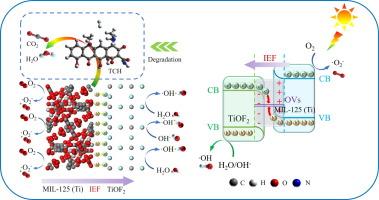构建 OVs 介导的 TiOF2/MIL-125 (Ti) S-scheme 异质结以高效破坏抗生素:机理、降解途径和毒性分析
IF 6.9
2区 材料科学
Q2 CHEMISTRY, PHYSICAL
引用次数: 0
摘要
光催化剂高效降解抗生素污染物是解决环境问题的必要手段。本文合成了一种S-scheme TiOF2/MIL-125 (Ti)异质结用于盐酸四环素(TCH)的降解。FT 1 - 10的动力学常数(0.01470 min−1)分别比TiOF2(0.00145 min−1)和MIL-125 (Ti)(0.00612 min−1)大10.1倍和2.4倍。在FT 1-10中,Ti4+/Ti3+的可变状态促进电荷平衡补偿,从而加速载流子分离,促进氧空位(OVs)的生成。OVs有助于减小带隙,扩大光响应范围,从而提高光催化能力。值得注意的是,功函数和XPS共同验证了,在异质结界面上,e-从MIL-125 (Ti)侧转移到TiOF2。在FT 1 ~ 10中,活性物质为·O2 -、·OH和h+。利用浓缩FuKui函数预测了TCH降解的潜在攻击位点,并基于LC-MS识别了TCH降解的可能途径。对TCH降解中间体进行的综合毒性和诱变性分析表明,FT 1-10具有环保性。一般来说,s型异质结具有独特的电荷传输途径和较强的氧化还原效应,有利于载流子的分离和传输。该研究为设计具有高效光催化性能的s -图式异质结提供了有价值的见解。本文章由计算机程序翻译,如有差异,请以英文原文为准。

Construction of OVs-mediated TiOF2/MIL-125 (Ti) S-scheme heterojunctions for efficient antibiotics destruction: Mechanism, degradation pathway, and toxicity analysis
The advancement of photocatalysts for high-efficiency degradation of antibiotic contaminants is essential in addressing environmental issues. Herein, an S-scheme TiOF2/MIL-125 (Ti) heterojunction is synthesized for tetracycline hydrochloride (TCH) degradation. The kinetic constant for FT 1–10 (0.01710 min−1) was 10.69 and 2.83 folds larger than TiOF2 (0.00160 min−1) and MIL-125 (Ti) (0.00604 min−1), correspondingly. In FT 1–10, the mutable state of Ti4+/Ti3+ facilitated charge balance compensation, thereby expediting carrier separation and promoting the generation of oxygen vacancies (OVs). OVs facilitated the reduction of bandgap and broadened the range of photoresponse, thereby enhancing photocatalytic capability. Notably, work function and XPS collectively validated that, on the heterojunction interface, e- transferred to TiOF2 from MIL-125 (Ti) side. In FT 1–10, the reactive species were ·O2–, ·OH and h+. Furthermore, potential attack sites in TCH degradation were forecasted utilizing condensed FuKui function, and the likely pathways of TCH degradation were identified based on LC-MS. Comprehensive toxicity and mutagenicity analyses performed on TCH degradation intermediates have demonstrated environmentally friendly nature of FT 1–10. Generally, S-scheme heterojunctions were favorable for carriers’ separation and transport due their unique charge transport pathways and strong redox effects. This study provides valuable insights into design S-scheme heterojunctions with efficient photocatalytic properties.
求助全文
通过发布文献求助,成功后即可免费获取论文全文。
去求助
来源期刊

Applied Surface Science
工程技术-材料科学:膜
CiteScore
12.50
自引率
7.50%
发文量
3393
审稿时长
67 days
期刊介绍:
Applied Surface Science covers topics contributing to a better understanding of surfaces, interfaces, nanostructures and their applications. The journal is concerned with scientific research on the atomic and molecular level of material properties determined with specific surface analytical techniques and/or computational methods, as well as the processing of such structures.
 求助内容:
求助内容: 应助结果提醒方式:
应助结果提醒方式:


